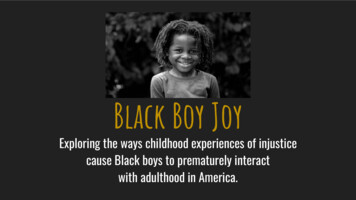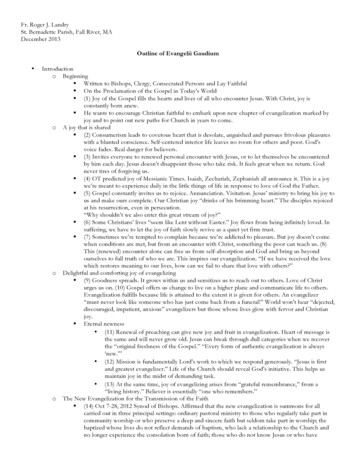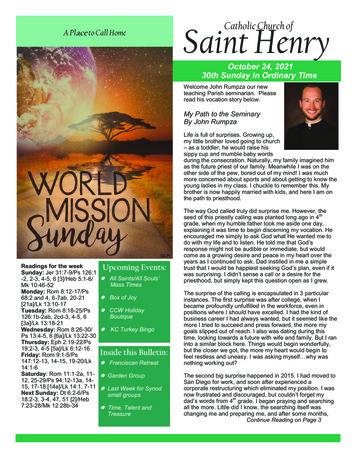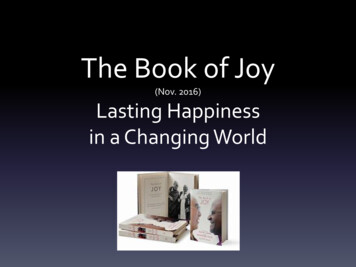
Transcription
Black Boy JoyExploring the ways childhood experiences of injusticecause Black boys to prematurely interactwith adulthood in America.
The American injustice system has stolen the innocence of black children for years.Through forced childhood experiences, black children are forced to ‘grow up’ and take onmore responsibilities than their white and non-black counterparts. According to a 2016article written for the Children and Youth Services Review, early adultification occurswhen a young person assumes premature self-sufficiency or is forced into adult-like rolesbefore they are emotionally prepared to do so. Children who face this stigma oftenreceive less emotional support within their school systems from teachers, more harshdisciplinary methods for minor infractions, and an increased interaction with theauthority, as discussed in a 2019 ‘Let Kid’s Be Kids’ article by Jennifer Sunami.Based on the 4 stages of Moral Development, studied by psychologist Jean Piaget,the brain is not fully developed until the formal operational stage which typically beginsaround age 12. From there, formal development continues into adulthood. This means ittakes about 12 years of uninterrupted development before the average person is able tofully control their emotions, judge risks, make logical decisions, and a multitude of otherrestrictions.What interruptions during childhood development can cause trauma thatsaffects operational development? & How do those interruptions advance theunequal treatment of young black boys in society?
why, prior to full development, are some children able to learn from their mistakes,while others of a particular race/background/experience are punished?When Black children make mistakes, they often face into conflict withauthority, much more often than their white equivalents. Tamir Rice was only 12years old when he was shot and killed by police officers, and Trayvon Martin, 17,becoming a young man was still only a child in the eyes of the law.Some of these childhood interruptions that lead to these tragedies will becovered in this watchlist, as well as the detrimental effects on the child and thecommunities they inhabit. It is important to be made aware of the injustices thatlead to adultification in order to save Black youth. Black Boy Joy, aims tounderstand the root cause of adultification for young black men and how we canunderstand the policies in place that are against them. Knowledge of the policiescan cause a reversal of these trends in order to help Black boys maintain theirinnocence.
AdoptionBlues for Nobody’s Child - A glimpse into Adoption for Black children in AmericaAlan, Debbie. “Blues for Nobody’s Child.” A Different World, Season 04 Episode 03, NBC, 1991.
AdoptionIn this episode of A Different World, Hillman College student, Winifred “Freddie” Brooks, advocates for her youngfriend, Alex, as she watches him struggle through the adoption process. As an 8-year-old, African-American boy inthe 90’s the show depicts his struggle to appeal to adoptive parents who are mostly looking for newborns andinfants to adopt. Though the characters are fictitious, the story is very real for young Black children in America.There is an assumption that adoption agencies treat all children equally. Unfortunately, a 2019 article by the PublicRadio International uncovered sad truths about the adoption system. African-American children, especially thosewith darker complexions, are adopted at fewer rates than light-skin and white children, despite more AfricanAmerican children being in the system. Additionally, black children cost less to adopt than white children. Colorismbegins young and it is unfair that children often spend months to years in foster care awaiting adoption, based ontheir skin tone.It is important for new families and couples to invest in children of color. According to the National Foster YouthInstitute, 20% of black boys who age out of the foster care system end up homeless, 60% as convicted felons and25% of kids suffer from PTSD. Black families and communities are most impacted by these statistics. Providingresources to place black youth in stable home environments early on, will only benefit communities in the long-run.
IncarcerationNova and Too SweetThe realities of children whohave experienced prisonAva, DuVernay. “All Good.” Queen Sugar, Season 01 Episode 11, OWN Network, 2016.
Since 2015, the rate of incarcerated youth among theAfrican-American community has grown significantly, accordingto the Equal Justice Initiative. Black boys are five times morelikely to be detained or committed to youth facilities than whitechildren. In The OWN Network’s Queen Sugar, issues pertainingto child incarceration are not uncommon. Episode 11 of Season1 displays the frustrations and hardship Too Sweet mustovercome, after being falsely imprisoned.The scene depicts the doubts Too Sweet has about his return tonormalcy and whether or not he will end up back in jail. In2016, 15-year-old Jaquin Thomas committed suicide after beingreleased from solitary confinement in adult prison. Even whensome young boys are released from prisons, they are notprovided the necessary tools and resources to gain theknowledge necessary to survive in American Society. The worldturns its back on them, and as a result, they often end up backin prisons or dead.Incarceration“In an era of racial segregation, especiallyresidential segregation, black youths’ livesare surrounded by police officers, and theirteenaged mistakes are more likely to land inthe juvenile justice system, White youth’smistakes are not.”Joshua Rovner, The Sentencing Project
Jeff, Davis. “Restoration.” Criminal Minds, Season 08 Episode 18, CBS, 2013.RestorationFacing Sexual Assault among men in the Black community.Sexual Abuse
Black boys across the country are sexually abused and assaulted at astounding ratesand it seems as though no one wants to talk about it. A BBC News reporter found thatone in six boys are abused by the age of 16 and those rates skyrocket when livingconditions, socioeconomic factors and other demographic disadvantages are taken intoconsideration. Much of this trauma impacts the child's future ability to perform andsexual preferences, despite the predator being a male or female, based on an EBONYstudy conducted by Nakitta Foston.Societal norms of masculinity are heavily distributed throughout the Black community.These pressures often dictate how masculinity should be executed by young men.Emotionally needy and sexual avoidance from women, do not “fit” those qualifications.This is a particular reason as to why sexual abuse and assault is underreported incommunities of color. Additionally, abusers are usually familiar to and trusted by thechild, further, when allegations do arise, the black community is guilty of keepingpredators ‘safe’ rather than the abused, says G. Hylton, a Level correspondent.The community must do better with holding predators accountable for their actions.Black boys deserve protection and innocence as much as any other child.Sexual Abuse
Norman, Milton Lear. “The ‘IQ’ Test.” Good Times, Season 02 Episode 07, CBS, 1974.EducationalDisparitiesThe “IQ” TestThe resources that make up a community have alarge impact on the education a student receives
EducationalDisparitiesThe 1945 Supreme Court case, Brown v. Board of Education, ruled that thesegregation of public school was unconstitutional. Unfortunately, effortsto desegregate schools has not been very successful in counties acrossthe country, as explained by MacArthur Genius, Nikole Hannah Jones.Inequality in the academic arena extends further than the educationalneeds of students. Lack of educational resources for students, lessexperienced teachers and lower quality curriculums all affect theeducational disparity and effect the further opportunity of many children.This clip from a 1974 episode of Good Times shows how the unequaldistribution of resources directly impacts Black children. When Blackstudents are not provided with the same educational resources as otherstudents, how can many of them be expected to receive the sameopportunities?
BrutalityBlack is BlackSpencer and Jordan exemplify extreme responses toracist encounters with authorityRobbie, Rogers. “i.” All American, Season 01 Episode 03, Clearwire, 2018.
Though the two boys come from completely different backgrounds andcommunities, in the eyes of the law, they are just black boys. Jordan andSpencer are both black teens growing up in California, however, their livedexperiences lead them to respond to conflict with the police in verydifferent ways. Spencer’s fear and compliance demonstrates the brutalityand violence has has experienced in his community. On the other hand,Jordan’s mouthiness and comfortability shows that the police do notrepresent a threat to him.Most Black parents have agree that having ‘The Talk’ with their children,especially young black boys who are often targeted by the police, is afundamental tool to help them stay alive in situations similar to the one inthe clip. It is a harsh reality, but it is necessary. Many black men are dyingat the hands of police brutality and it takes understanding and compliancebetween both parties to resolve the issue at hand.Brutality
The Water DancerTa-Nehisi CoatesThrough the protagonist, Hiram Walker, The WaterDancer paints a story of ‘what if.’ Offering analternate history to the narrative of enslaved blackmen and women in the United States. What wouldhave happened if black people had innate powers toescape slavery? How would the existence of Blackboys look if they had an opportunity to escapeoppression and the systems which oppress them?Perhaps their innocence would be spared.
Black boys are the heart of our black communities.So much is expected of a black man, yet so littleresources are made available to them. We often talkabout the protection of our black children, but neglectto advocate for the protection and skills black youngmen need to survive in a society that treats them likemen before they have the experience to be.Going forward, I will make a conscious effort toadvocate for black men, in addition to my black sisters.This project opened my eyes to a lot ofthe disparity and underrepresentationblack men, specifically, face in the world.Though some of these issues also greatlyaffect black women, there are feweroutlets for black men to express theirsentimentstowardchildsexualassault/abuse, the traumas of adoption,and the overall pressures of becoming ablack man.If we want our black men to be able toadvocate and protect their communities,they must be shown love, support andsecurity while they are young.They have to exude Black Boy Joy.
this isBlack Boy Joy{Presented by Kayla McLaurin}Additional resources to engage:1.2.3.4.5.6.Black men explain what Black Boy Joy means to themSexual assault hotline - (800) 656 HOPE#BlackLivesMatter & #PoliceLivesMatter - 10suggestions to remember when engaging with thePoliceUnderstanding the needs of black boys in classroomsBreaking the cycle of IncarcerationInterested in adopting an African-American child?
Black Boy Joy {Presented by Kayla McLaurin} Additional resources to engage: 1. Black men explain what Black Boy Joy means to them 2. Sexual assault hotline - (800) 656 HOPE 3. #BlackLivesMatter & #PoliceLivesMatter - 10 suggestions to remember when engaging with the Police










